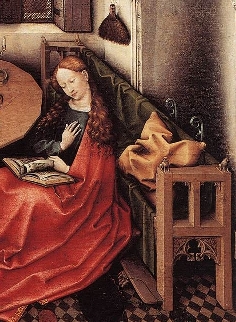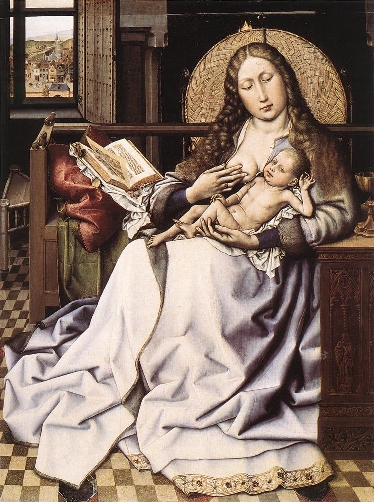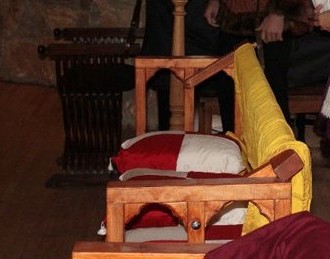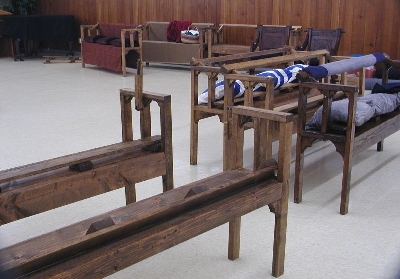As part of a crazy plot to take over the world, a team of us got together and decided that we needed benches to do so. Not just any benches - 15th C. benches! I was tasked with research and plan generation, and a bunch of us got together over a couple of weekends and turned out a dozen of these benches.
We look again to our wonderful Flemish artists for their sublime attention to realism and detail. There are four works from the period of 1420 to 1440 which show wonderful detail of some benches. They are all in a similar style, however they show some interesting differences.

Annunciation (Detail)
Campin, Robert - 1420s.
|

Merode Alterpiece (Right Wing, Detail)
Campin/Master of Flemalle - c. 1427.
|

Werl Alterpiece (Detail)
Attributed to Campin - 1438.
|

Virgin and Child
Follower of Campin - 1440.
|
From the above paintings, we can instantly note some similarities. The first three have little animals at the corners of the benches (they appear to be lambs or dogs - either would be appropriate, the lamb symbolizing the Lamb of God, and the dog a symbol of loyalty). They all are placed in front of a fireplace, and of the two we can see the sides of, they both have a "dual window" design with four supports on the top and two supports on the bottom. Interestingly enough, those same benches also have a back rest that is hinged. To be more specific, the back rest can be switched over so that if one wishes to sit on the other side of the bench, one needs but to stand, switch the back rest, and then walk around and sit down. This is pure supposition on my part, but I suspect that, based on the bench's proximity to the fireplace, that this could likely have been used to warm one's back as well as the front, based on the Virgin's whim. They also have two footed footrests, which may or may not be attached to the base of the bench itself. We also observe cushions and a backdrop on all three, either placed simply on the base of the bench itself and draping down, or also draping over the backrest as well as the base.
However, it is the third design, from the 1438 Werl Alterpiece, which we take our primary inspiration from. There are several things to note on this bench. Again, we see the two windowed design, foot rests, and hinged back, all before the fireplace. We also observe cushions and a backdrop. You will observe that there are no little animals on the sides of the benches - the reason is clearly to allow the moveable back rest to function properly.
The original prototype, which is pictured here, originally did not incorporate the hinged back (the back was fixed), nor did it have all six side triangular supports (only four were used). Additionally, the bench was a little narrow because of the lack of availability of inexpensive wide lumber. The production models incorporated all six supports and a wider seat.
The bench is made of pine, although in period, a much harder wood such as oak would likely have been used. Pine was chosen due to its cost and machineability. The entire bench breaks down via the use of bedrail hardware concealed inside the long support pieces and the sides of the bench. The seat simply lays into a grooved edge in the support pieces. As observed, the footrest is not attached to the bench itself. This is done so that it can be easily packed in a vehicle, and it was noted that the sitter is much more comfortable when the footrest is slid out several inches from the bench.
|

|
As mentioned before, the bench is a little narrow due to the lack of availability of wide lumber. In the mass production models, this was increased by using a separate 2x2 attached to the side support for the seat to lay on, and 1x2s used as spacers to increase the depth even further. See the diagram. In the third revision of these benches (I made several out of poplar much later) I ended up using thick plywood reinforced on the bottom for the seat - it is lighter, one can cut it to any size, and the plywood raw edges are hidden by the bench.
|

|
The footrest "claws" were carved by sanding down one edge to curve it, and then using the edge of a sanding belt to carve the grooves to replicate claws. The entire bench was stained with a dark water based stain and then covered up with modern polyurethane in the interests of time.
|

|
The reconstruction bench replicates the look and feel of the more robust furniture displayed in the portraits, but with inexpensive and lightweight materials. The sponsorship fee for the bench was only $40, which covered the entire cost of materials. From the commentary from those who actually sat on the benches for the three hours of feast, they were fairly positive and said that the benches encouraged good posture, although one can easily drape one's arm on the side or backrest to lounge a bit. The screws holding the solid pieces together are hidden with wooden caps, also stained, and they give an authentic appearance of dowels used to hold the pieces together.
|
 (c) Cin Barnes
(c) Cin Barnes
|
As can be seen in this and the above photos, the production models all have arms that can allow the back rest to be swung up and around in order to change sides. One only needs to move the footrest to make the transition complete!
|
 (c) Cin Barnes
(c) Cin Barnes
|








